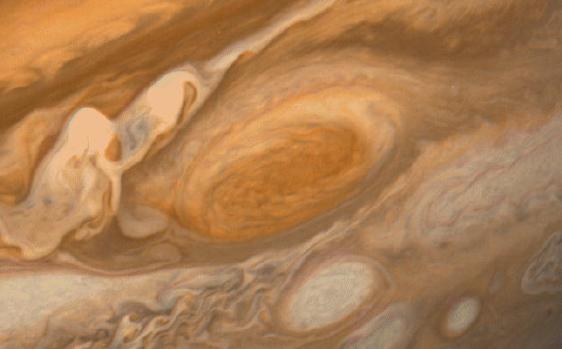

It will be a busy day for the spacecraft and its recently separated atmospheric probe. After a detailed choreography of data gathering and critical engineering, Galileo will be the first spacecraft to enter orbit around one of our giant outer planets. It will also be the first to send instrumented probes directly into one of their atmospheres. The spacecraft will then begin at least two years of close-up observations of Jupiter, its moons, its faint rings, and its powerful radiation, magnetic field, and dust environment.
Jupiter is a very interesting planet to explore. It is 318 times more massive and 1400 times more voluminous than Earth, but only a fourth as dense. The planet is primarily known for the banded appearance of its upper atmosphere and its centuries-old Great Red Spot, a massive, hurricane-like storm as big as three Earths. Jupiter also generates the biggest and most powerful planetary magnetic field, and it radiates more heat from internal sources than it receives from the Sun. Dr. Wesley T. Huntress, Associate Administrator for Space Science at NASA Headquarters, says that "in may ways, Jupiter is like a miniature solar system in itself. Within Jupiter's constellation of diverse moons, its intense magnetic field, and its swarms of dust and charged particles, the Galileo mission should uncover new clues about how the Sun and the planets formed, and about how they continue to interact and evolve."
The instruments on board the Galileo spacecraft represent the most capable paylod of experiements ever sent to another planet. The data that is hoped to be gained promises to revolutionize our understanding of the Jovian system and reveal important clues about the formation and evolution of the solar system.
The two and a half ton Galileo orbiter spacecraft carries 10 scientific instruments, and the 746 pound probe carries six more instruments. The spacecraft radio link to Earth and the probe-to-orbiter radio link serve as instruments for additional scientific investigations.
The chain of key mission events begins with a close flyby of the moon Io by the orbiter at a distance of 600 miles. Io's gravity will change Galileo's direction to help it go into orbit around Jupiter. Due to high radiation in the interior region of te Jovian system, this is the closest that Galileo has been scheduled to come to this moon, although observing of Io will be accomplished during many subsequent orbits.
Four hours after the first Io flyby, the orbiter will link up with the previously released Galileo probe by radio. By this time, the probe will have slammed into the upper fringe of Jupiter's atmosphere at a top speed of 106 000 mph and endured deceleration forces as high as 230 times Earth's gravity. As it drops downward on its parachute, the probe will make the first direct measurements of Jupiter's atmosphere and clouds.
The orbiter will record measurements readioed from the probe for up to 75 minutes, then will undergo a burn to insert the spacecraft into Jovian orbit. Only a few hours later the probe is expected to succumb to the increasingly intense heat below the clouds.
After orbit insertion, the Galileo orbiter will embark on a tour of at least 11 orbits in the Jovian system, including close encounters with Ganymede, Callisto, Europa, and Io. By mid-March, Galileo will be ready to fire its engine again to exit the most intense Jovian radiation environment.

 |